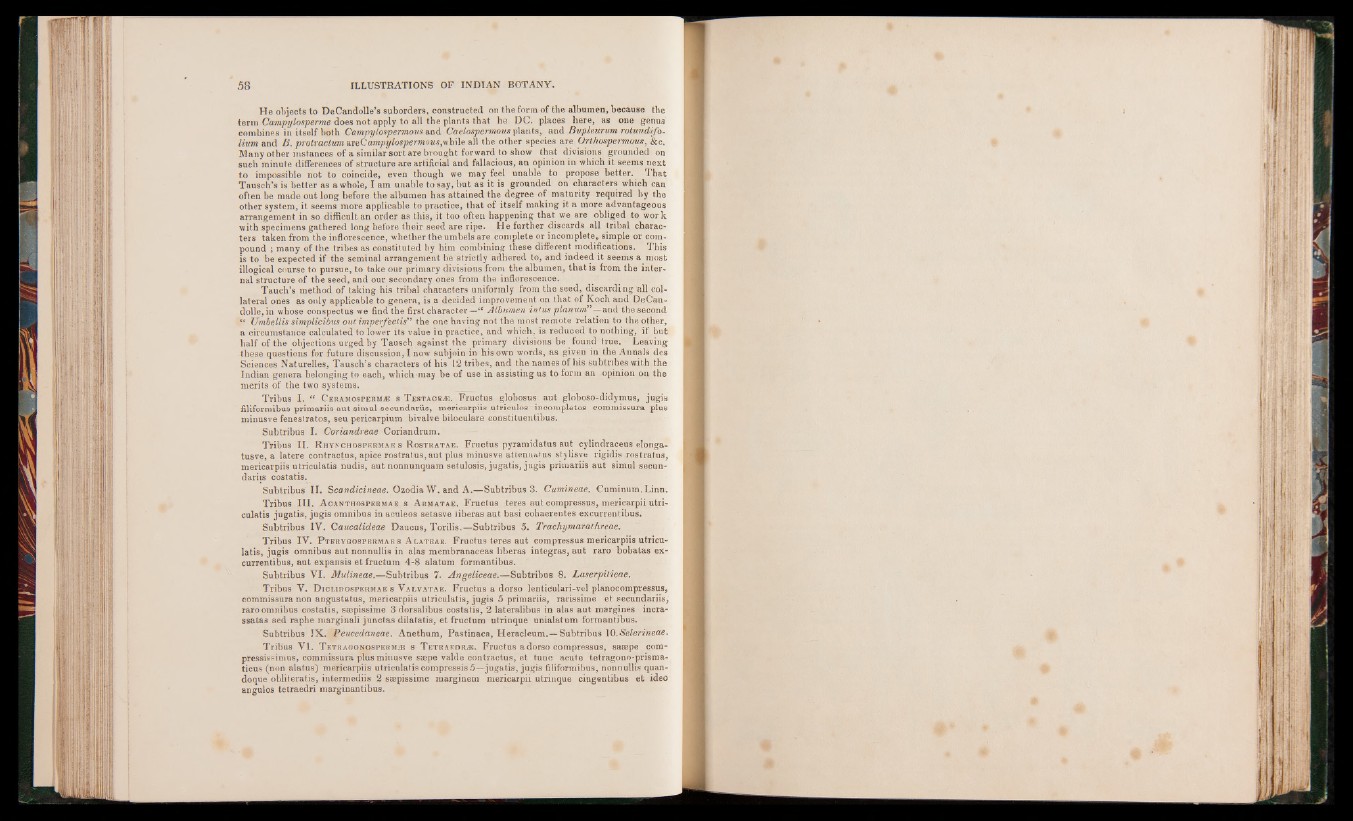
He objects to DeCandolle’s suborders, constructed on the form of the albumen, because the
term Campylosperme does not apply to all the plants that he DC. places here, as one genus
combines in itself both Campy lospermous and Caelospermous plants, and Bupleurum rotundifo-
lium and B. protractum areCampylospermous,vjhi 1 e all the other species are Orthospermous, &c.
Many other instances of a similar sort are brought forward to show that divisions grounded on
such minute differences of structure are artificial and fallacious, an opinion in which it seems next
to impossible not to coincide, even though we may feel unable to propose better. 1 hat
Tausch’s is better as a whole, I am unable to say, but as it is grounded on characters which can
often be made out long before the albumen has attained the degree of maturity required by the
other system, it seems more applicable to practice, that of itself making it a more advantageous
arrangement in so difficult an order as this, it too often happening that we are obliged to work
with specimens gathered long before their seed are ripe. He further discards all tribal characters
taken from the inflorescence, whether the umbels are complete or incomplete, simple or compound
; many of the tribes as constituted by him combining these different modifications. This
is to be expected if the seminal arrangement be strictly adhered to, and indeed it seems a most
illogical course to pursue, to take our primary divisions from the albumen, that is from the internal
structure of the seed, and our secondary ones from the inflorescence.
Tauch’s method of taking his tribal characters uniformly frpm the seed, discarding all collateral
ones as only applicable to genera, is a decided improvement on that of Koch and DeCan-
dolle, in whose conspectus we find the first character —t( Albumen inf us planum91—and the second
“ Umbellis simplicibus out imperfectis” the one having not the most remote relation to the other,
a circumstance calculated to lower its value in practice, and which, is reduced to nothing, if but
half of the objections urged by Tausch against the primary divisions be found true. Leaving
these questions for future discussion, I now subjoin in his own words, as given in the Annals des
Sciences Naturelles, Tausch’s characters of his 12 tribes, and the names of his subtribes with the
Indian genera belonging to each, which may be of use in assisting us to form an opinion on the
merits of the two systems.
Tribus I. f Ceramosperm*; s T estacb.®. Fructus globosus aut globoso-didymus, jugis
filiformibus primariis aut simul secundariis, mericarpiis utriculosrincompletos commissura plus
minusve feneslratos, seu pericarpium bivalve biloculare constituentibus.
Sub tribus I. Coriandreae Coriandrum.
Tribus II. R hynchospermae s Rostratae. Fructus pyramidatus aut cylindraceus elonga-
tusve, a latere contractus, apice rostratus, aut plus minusve attenuatus stylisve rigidis rostratus,
mericarpiis utriculatis nudis, aut nonnunquam setulosis, jugatis, jugis primariis aut simul secundariis
costatis.
Sub tribus II. Scandicineae. Ozodia W. and A.—Subtribus 3. Cumineae. Cuminum.Linn.
Tribus III. Acanthospermae s A rmatae. Fructus teres aut compressus, mericarpii utriculatis
jugatis, jugis omnibus in aculeos setasve liberas aut basi cohaerentes excurrentibus.
Subtribus IV. Caucalideae Daucus, Torilis.—Subtribus 5. Trachymarathreae.
Tribus IV. P tbrygospermae s Alateae. Fructus teres aut compressus mericarpiis utriculatis,
jugis omnibus aut nonnullis in alas membranaceas liberas integras, aut raro bobatas excurrentibus,
aut expansis et fructum 4-8 alatum formantibus.
Subtribus VI. Mulineae.—Subtribus 7. Angeliceae.—Subtribus 8. Laserpitieae.
Tribus V. Diclidospermae s Valvatae. Fructus a dorso lenticulari-vel planocompressus,
commissura non angustatus, mericarpiis utriculatis, jugis 5 primariis, rarissime et secundariis,
raro omnibus costatis, ssepissime 3 dorsalibus costatis, 2 lateralibus in alas aut margines incra-
ssatas sed raphe marginali junctas dilatatis, et fructum utrinque unialatum formantibus.
Subtribus JX. Peucedaneae. Anethum, Pastinaca, Heracleum.— Subtribus 10.Selerineae.
Trib'us VI. T etragonosperm.® s T etraedr.®. Fructus a dorso compressus, saaepe com-
pressissimus, commissura plus minusve saepe valde contractus, et tunc acute tetragono-prisma-
ticus (non alatus) mericarpiis utriculatis compressis 5—jugatis, jugis filiformibus, nonnullis quan-
doque obliteratis, intermediis 2 seepissimc marginem mericarpii utrinque cingentibus et ideo
angulos tetraedri marginantibus.